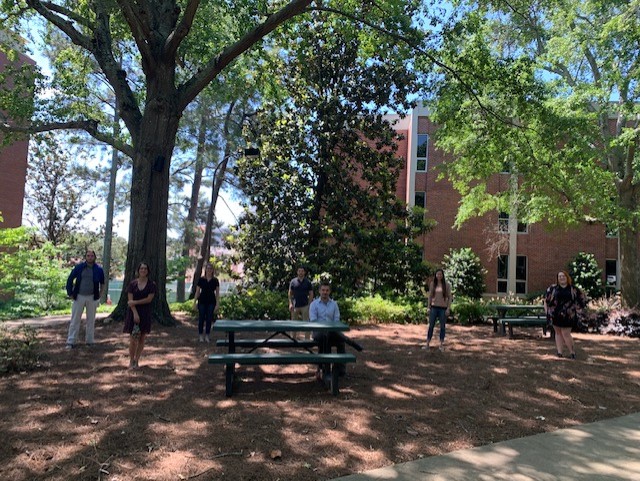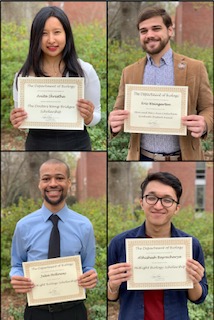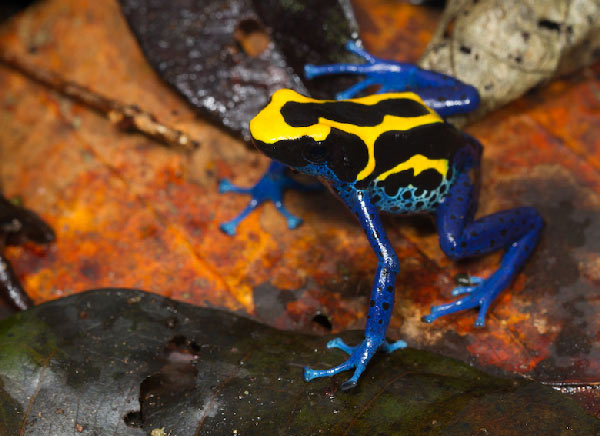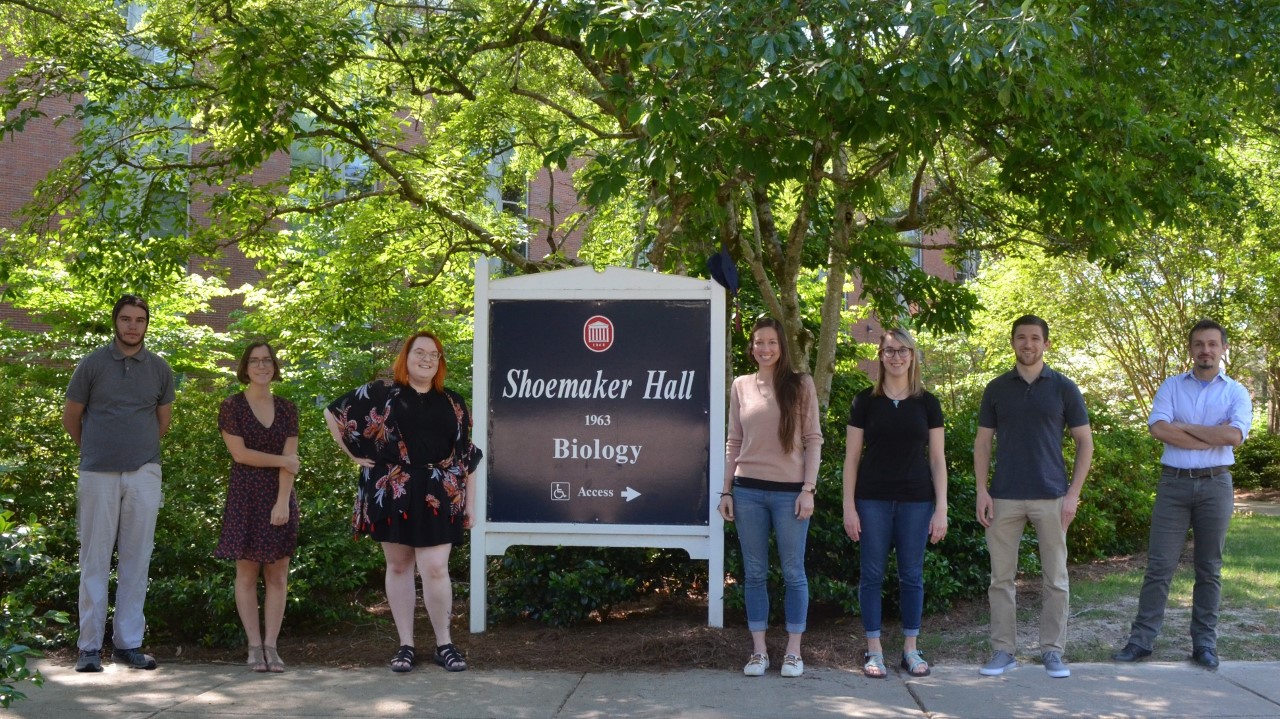This new grant is to study the Caulobacter crescentus pilus. Pili are cell structures bacteria use to attach to surfaces, as well as perform other functions. The C. crescentus pilus is a rare sub-type that has hardly been studied, and there are a couple unusual facets to it that we and others have uncovered. The grant will focus on two of these. First is the regulation of the pilA gene, which encodes the subunit that makes up the pilus filament. Our data suggests that this gene may use a completely novel regulatory mechanism, and we aim to understand that mechanism. The second part explores how the pilus becomes localized to the cell pole, something we know little about, and may be tied to the localization of developmental signaling proteins.
Archive for the ‘news’ Category
Dr. Wayne Gray offers some insights that may help the public understand the COVID-19 pandemic
 Dr. Wayne Gray, a virologist in the with more than 40 years’ experience studying viruses, is offering some insights that may help the public understand the COVID-19 pandemic.
Dr. Wayne Gray, a virologist in the with more than 40 years’ experience studying viruses, is offering some insights that may help the public understand the COVID-19 pandemic.
Click here to read the full article.
Congrats to our newest M.S. and Ph.D. Graduates!!
Pictured left to right:
Reed Scott, M.S.
Brooke Sykes, M.S.
Sarah Amonett, M.S.
Sarah McNamara, M.S.
Maya Kaup, M.S.
Kevin Potts, M.S.
Chaz Hyseni, Ph.D.
Congrats to the advisors of our new graduates: Dr. William Resetarits, Dr. Susan Balenger, Dr. Erik Hom, Dr. Ryan Garrick.
How did we take these pictures while maintaining social distancing? Well, thanks to the photo-editing skills of Brooke Sykes, MS 2020, we took photographs of each graduate separately and then carefully edited them together. We even did a masked version…just to be safe!

Our graduating students couldn’t resist one last, socially distanced, trip to our Biology tailgating spot near Shoemaker Hall.

6th Annual Neuroscience Research Showcase WINNERS!!!
CONGRATULATIONS to the following winners of the poster competition for the 6th annual Neuroscience Research Showcase!!
Graduate Student Winners:
1st Place: Alaa N. Qrareya, Department of Biomedical Sciences, Advisor: Jason Paris.
“HIV-1 Tat Promotes Age-Related Cognitive, Anxiety-like, and Antinociceptive Impairments in Mice that are Moderated by Aging Endocrine Status .”
Honorable Mention: Salahuddin Mohammed, Pharmacology, Advisor: Jason Paris.
“HIV-1 Tat Dysregulates the Hypothalamic-Pituitary-Adrenal Stress Axis and Potentiates Oxycodone-mediated Psychomotor and Anxiety-like Behavior of Male Mice”.
Undergraduate Student Winners:
1st Place (2nd Year in a row!): Nikki Sullivan, Biology Major with Neuroscience & Chemistry minors, Advisor: Alberto del Arco.
“Effects of repeated intermittent episodes of social stress on the acquisition and extinction of a reward-seeking task.”
2nd Place: Zahra Jiwani, Catherine Kania, and Perry Mullins, Biology Majors with Neuroscience minor (ZJ), Advisor: Lainy Day.
“Exploration of cerebellar function in Taeniopygia guttata using spatial maze and log roll.”
Honorable Mention: Luke Nguyen, Biochemistry Major, Advisor: Lainy Day.
“Novel understanding of avian biomechanics and sonations usinghigh-speed video of the white-ruffed manakin (Corapipo altera altera).”
Despite a global pandemic, we carried on online and had 13 presenters and 11 separate posters. Posters with citation details and filmed zoom presentations will soon be up on eGrove, details to follow!
Special thanks for our judges: Tossi Ikuta, Nicole Ashpole, Jason Paris, Carolyn Higdon, Kristie Willett, Xin Ye, and Robert Doerksen
Congrats Dr. Tammy Goulet on becoming an ICRS Fellow!!
 Dr. Tammy Goulet has been selected as an International Coral Reef Society (ICRS) Fellow.
Dr. Tammy Goulet has been selected as an International Coral Reef Society (ICRS) Fellow.
She was unanimously selected in recognition of her scientific achievement and her service to the Society. This award is a “for life” award while maintaining her ICRS membership. She will receive a certificate as well as invited to participate in selecting new fellows.
CONGRATULATIONS!!!
Congrats graduate students on receiving scholarships!!
 CONGRATULATIONS to these graduate students on receiving scholarships!!!
CONGRATULATIONS to these graduate students on receiving scholarships!!!
•Anita Shrestha – The Doctors Wong-Bridges Scholarship Graduate Student Award
•Jalen Holloway – McRight Biology Scholarship
•Eric Weingarten – Steve and Mary Ann Cockerham
•Abhishesh Bajracharya – McRight Biology Scholarship
Scientific society names award after Biology professor
The Animal Behavior Society Conservation Committee has established the Richard Buchholz Conservation Behavior Award. This award is named after Dr. Richard Buchholz to honor his foundational and continuing work in integrating the fields of animal behavior and conservation biology. The award will be given annually starting in 2020.
Want to know more about conservation behavior? Click here.
Biology Professor Selected as Ambassador for Nationwide Program
Tamar Goulet will mentor teen girls to encourage interest in STEM fields

Tamar Goulet, UM professor of biology, has been selected as one of 125 female ambassadors for a new program, launched by the American Association for the Advancement of Science in conjunction with Dallas-based Lydia Hill philanthropies, to encourage girls to pursue STEM education and careers. Photo by Robert Jordan
SEPTEMBER 23, 2019 BY ABIGAIL MEISEL
Tamar L. Goulet, University of Mississippi professor of biology, has been selected as one of 125 female ambassadors for a new nationwide education program.
The program, launched by the American Association for the Advancement of Science in conjunction with Dallas-based Lydia Hill philanthropies, is designed to provide role models and support in math and science to middle-school girls to encourage their interest in STEM education and careers.
The academic IF/THEN Ambassadors were chosen based on their research, commitment to teaching and professional accomplishments. As an IF/THEN program ambassador, Goulet will connect with female students ages 11-13 in person and through various media platforms, including YouTube channels, and provide individual coaching via Skype.
“A scientist should not only excel in science but also facilitate understanding of, and foster enthusiasm for, science,” Goulet said. “My career combines novel innovative research in science and teaching with science communication and mentorship.”
Goulet, who joined the UM faculty in 2001, has published numerous papers on the symbioses between cnidarians – including corals, octocorals and sea anemones – and their mutualistic algae. Her work has received funding from the National Science Foundation, NASA and the National Oceanic and Atmospheric Administration.
She teaches graduate and undergraduate courses in biology.
In 2008, she received the College of Liberal Arts’ Cora Lee Graham Award for Outstanding Teaching of Freshmen. In 2018, she received an honorable mention Teaching Excellence Award from the Personalized Learning and Adaptive Teaching Opportunities Program.
“Professor Goulet is an accomplished researcher who has also devoted her career to teaching and mentoring students,” said Lee M. Cohen, dean of the College of Liberal Arts. “The University of Mississippi has been the lucky beneficiary of both these talents.
“I know her passion for teaching will help ignite enthusiasm for STEM in the country’s next generation of female budding scientists.”
Survival of the Weakest
Professor Brice Noonan Puts a New Spin on Evolutionary Biology

Dyeing Poison Frog (Dendrobates tinctorius) from the Kaw Mountains, French Guiana. Photo by J.P. Lawrence
SEPTEMBER 19, 2019 BY ABIGAIL MEISEL
When he was a teenager in south Florida, Brice Noonan discovered a new love that ultimately shaped the course of his life.
“I became enamored of frogs in high school,” said Noonan, an associate professor in the Department of Biology.
His fascination increased when he learned about a specific species of South American frogs: poison dart frogs, so called because several indigenous peoples have used them to tip blowgun darts. The frog secretes a life-threatening bitter poison as its natural defense.
Noonan discovered a store near his childhood home that imported reptiles and amphibians, including poison dart frogs, so he had a ready supply to study.
Decades later, his homespun investigations evolved into the scientific article, “Weak Warning Signals Can Persist in the Absence of Gene Flow,” published earlier this month in Proceedings of the National Academy of Sciences (PNAS). The study was featured last Thursday in the New York Times.
“There are several variations of this species of poison dart frog, and they have different colorations,” said Noonan. “Most are blue and black with bright yellow markings, but some populations of the same species have white stripes instead of yellow ones. That type of variation within a species is incredibly rare. It was a conundrum as to why the species was so variable.”
The answer was unexpected. The yellow-marked frogs have a stronger poison than their white-striped counterparts. Their predators, chiefly birds, spot the brilliant yellow from afar and know to stay away. Yellow reads as “danger.”
The white-striped frogs have a less potent toxin, which would seemingly make them more vulnerable to the same predators—but they’re not.
“These frogs live close to the bold and ostentatious yellow frogs, but not among them—about five miles away,” said Noonan. “But they are harder to detect and far less recognizable to birds. Birds are more afraid of something they’ve never seen than something that they’ve tried that has toxins. So, they stay away.”
Noonan’s research, funded by the Centre National de la Recherche Scientifique (France), was a collaboration with a nine-member international team that was led by one of his former students, J.P. Lawrence. Now a postdoctoral researcher at the University of California at Irvine, Lawrence served as the lead author on the PNAS article.
Noonan is dedicated to mentoring not only graduate students but also undergraduates. He teaches a section of UM’s introductory biology class as well as upper-level courses. During the upcoming winter session, he will teach a course in the Caribbean for UM students.
“I’ve loved reptiles and amphibians since I was a little kid,” he said. “Then, when I was at a community college in south Florida, I discovered scientific journal articles, which changed my life.”
Now, he’s writing them.

 The Bloomekatz laboratory contributes to a recently published paper in Developmental Cell on the signals that regulate the formation of specialized pacemaker cells, which regulate the speed and rhythmicity of the heart.
The Bloomekatz laboratory contributes to a recently published paper in Developmental Cell on the signals that regulate the formation of specialized pacemaker cells, which regulate the speed and rhythmicity of the heart.